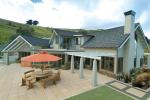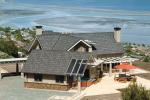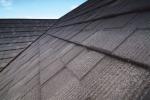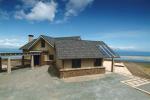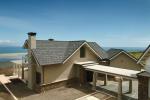Making The Most Of Everything
Architect Aidan Pykett, working together with owners John & Glenys Taylor, have created a unique environment which capitalises on the natural panorama and sunshine offered by the site and minimises the impact of very high winds in the area.
The Brief:
Owners John & Glenys Taylor come from a farming background and wanted their new home to reflect this heritage.
The home should be light and airy and yet feel solid and well grounded.
The site offers extensive views over Tasman Bay which John and Glenys wanted to make the most of. Due to it’s elevated position the site experiences very high winds which required careful planning to create sheltered outdoor entertainment areas.
Specific practical requirements were:
- To house a collection of antiques in an otherwise contemporary design.
- To enjoy the space of double the usual stud height in the lounge and dinning area.
- To incorporate an open fire in the lounge
- To have the master bedroom on the ground level.
- To provide a self contained flat with separate outdoor living space for a family member above the garaging.
- To have 2 guest bedrooms.
- To create a family, office and breakfast area which would be cosy and take full advantage of the morning sun.
- To provide garaging for three vehicles and...not least to take advantage of the high sunshine hours by utilising passive solar heating.
Design response:
The location of this site and the position of the home on the site was the first major consideration. How best could the natural beauty of the views be balanced against the severe winds experienced in the area.
The house sits on a natural bench in a steep hillside 90 metres above sea level. The hillside behind the bench was excavated to “pull” the house back as far as was practical to tie it into the landscape, reduce the impact of road noise from the State highway and reduce the visual impact of the house to the highway. This gave the added benefit of increased shelter to outdoor areas for the main house and allowed the flat above the garaging to open out at the same level onto it’s own private outdoor area on the uphill side.
Consideration to the living comfort of the house was planned at the outset. It was important that the whole house, including the large and high living spaces, remain comfortably warm all night without supplementary heating in the winter and cool in the summer. The large areas of North and North West glazing took full advantage of the excellent views across Tasman Bay and Nelson and provided a light and airy feel. These were double glazed.
The insulated concrete floor slab and masonry elements within the building created heat sinks which, combined with better than standard insulation for the roof and walls, all combined to enable efficient passive solar heating.
Numerous products were considered prior to making the roof cladding decision. “We originally considered various bitumen based shingles but none, we looked at, could stand up to the very high wind speeds encountered on this exposed site,’’ says Aidan. Gerard Senator Shingles were chosen for their non-reflective qualities (which further reduced the visual impact from the state highway), their low profiled textured appearance,secure fixing and high wind rating.
Box trim was chosen in lieu of the usual angle trim to give a flatter
look at the ridges, hips and barges.
Solidity and grounding are achieved by means of a schist plinth which visually ties the building to the ground. The pitched roof, tapering chimneys and columns add to this effect.
Pushing the living areas out in front of the building allowed uninterrupted views from these spaces and an easy flow from them to the outdoor living areas. This provides a choice of outdoor spaces, one of which is always sheltered from the wind, which was a major consideration with site planning.

